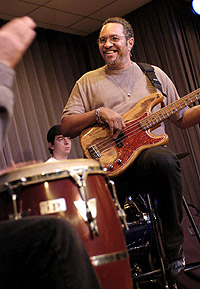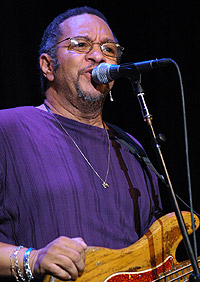Meter Man

George Porter, Jr. performs with Berklee's Meters Ensemble during a Berklee masters class.
Nick Balkin

Porter sang lead on several tunes at the Second Line Resurrection concert.
Phil Farnsworth
New Orleans has always been the kind of place where sharp changes in music history occur under what might seem like ordinary circumstances. If it weren't for a walking route George Porter, Jr. used to take to school—one that introduced him to bassist Benjamin "Popi" Francis—Porter might still be a classical guitarist, rather than one of the funkiest bass players to walk the earth.
"I used to pass Popi and his grandfather playing on the steps on Saturday mornings and they were using classical formula but playing "St. Louis Blues" and "Honky Tonk," said Porter at a masters class he gave last November as part of Berklee's New Orleans Visiting Artist (NOVA) Series. At his next school recital, Porter played his own version of "St. Louis Blues," taking a bold step toward becoming the man who would someday help the Meters define the sound of down-home Crescent City funk.
From all reports, students fortunate to play with Porter during his Berklee visit were impacted as heavily as Porter was by Popi. For bassist Brian Quinn, it was a chance to see and hear, up-close, how Porter gets his bass sound.
"Yesterday I spent all two hours just staring at his hands," said Quinn, who played with Porter and the other members of Berklee's Meters Ensemble during the masters class. "For years I've been listening to his work and really digging his tone, really digging his pocket. To see the machines that give you that pocket at work . . . I've just been studying them."
Quinn had no trouble keeping up with Porter, and anchoring the band—Quinn, keyboardist Koichi Sato, guitarist Shinichi Kato, and drummer Adam Deuplisea—on the three Meters classics the group played: "Cissy Strut," "Funky Miracle," and "Live Wire." According to ensemble instructor Bob Tamagni, associate professor of percussion, just being around Porter made the entire group better because of his approach to playing the bass.
"He doesn't play like it's in your face. He just wants to contribute to the whole and make the band sound better. It commands for you to listen to him," said Tamagni. "Everybody was playing lighter—just a little more focused on listening and hearing what he was playing."
Tamagni, who has been leading the Meters ensemble for about ten years, uses no sheet music in his rehearsals. He has students learn the songs by ear, guiding them as they pull riffs off the Meters' recordings, urging them to work on nailing the feel of the music. "You get it in there a little deeper if you learn it by ear," Tamagni said.
The cohesiveness of Tamagni's group—tight on executing the key rhythms but loose and open enough to give the music a feel that was both butt-shaking and flowing—harkened back to the sound of the original Meters, whose four members recently reunited, forty years after first coming together.
One thing Porter's Meters and the student version might not have in common is their practice schedule. Tamagni's Meters play for a minimum of two hours every week, but even in its early days, Porter's group avoided such a schedule.
"We never rehearsed," Porter said "We just went out and played it. And a lot of our music was written on the gig . . . when we had one album out, all we had was 30 minutes of music, so we had to do a lot of jamming and made up a lot of stuff right on the spot."
Porter and his bandmates—keyboardist and vocalist Art Nevillie, guitarist Leo Nocentelli, and drummer Ziggy Modaliste—listened to tapes of their gigs and picked out riffs and melodies that would become the building blocks of their songs.
But Porter says there's at least one example of the band writing a tune not at a gig, but on the road. The group came up with "Look-Ka Py Py" while driving from Washington D.C. to Atlanta for an early recording session.
"We burned a couple of pistons out in our mercury station wagon . . . and the vehicle was making this sound: 'pooka-chee ooh, pooka-chee uh, pooka-chee ooh, pooka-chee uh.' Before you know it, Leo and Zig was beating on stuff and we're singing, 'bon-shoo bon-bon, bon-shoo bon-bon,' and we sang that for a couple of hundred miles," Porter said. "When we got to the studio, Leo came up with the lick, I came up with the second lick, and that was the song. That's the way so many things happened with our music."
The Meters' repertoire was on display, as was Porter's bass playing, during Second Line Resurrection, a concert in the Berklee Performance Center on November 29 whose proceeds benefitted the NOVA Fund. The show featured Porter not only playing bass, but singing lead on several tunes. Other performers included saxophonist Donald Harrison—an alumnus and New Orleans native—alumnus guitarist Mark Whitfield; Berklee's Jazz Hip-Hop Orchestra, directed by former faculty member Angelamia Bachemin, another musician from the Big Easy; and Louisiana's Jaguar Alumni Drumline.
It was a high-energy night of music, dancing, and celebrating one of the most musical cities in the world. It also provided evidence that no matter how rough things are in New Orleans, its music is stronger than ever. Bringing that music north has been a boon for Berklee and its students, and it's also underscored the importance of ensuring that New Orleans and its neighborhoods fully rebound, so that the George Porters of the future might walk down their local streets and hear sounds that might change them, and the music world, forever.
